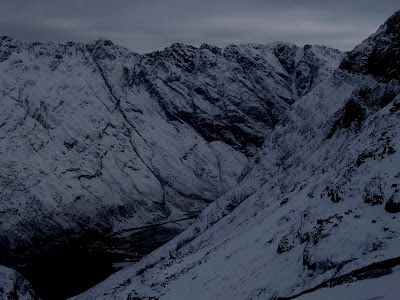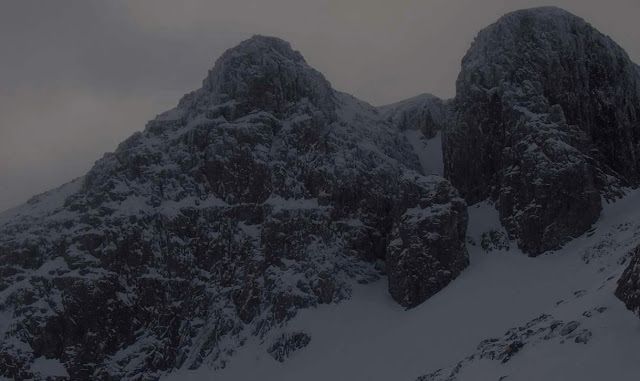The ordinary experience on the UK’s mountains can be a predictable one. The weather is either middling, with low cloud, blustery wind and a splutter of rain, or it’s downright terrible–but you lace up your boots anyway, telling yourself you need the exercise. You reach the summit cocooned in your own world of damp Goretex and zero visibility. It’s definitely a hill (look, there’s the cairn so it must be the top!) but the experience is lacking somehow, and deep down you know there have been better days than this.
The goal of the mountaineer is to seek the extraordinary experiences. They are not always comfortable or safe, but they reaffirm what it is to be alive, and they are never forgotten.
Moonlight and avalanche
In January 2010 I was living at the Clachaig Inn, Glencoe, and regularly getting out into the mountains. We called that season the “Winter of Legends” afterwards, because it kept on giving and never seemed to end: seven months of snow, deep cold, clear days, and the ice encroaching ever deeper into the glens. The river Coe froze to its bed and the Upper Falls of Coire Bheith became a pillar of pure water ice.
It was an extraordinary time, and I was immersed in the romance of it all. I was no longer satisfied by ordinary days on the hill.
Late in that month I began to wander the mountains at night. A landscape is transformed by the onset of darkness, and it becomes a magical realm where space and time distort and the senses are unleashed to roam at will over the land. If the sky is cloudy, the universe narrows to a cone of light projected from the headtorch strapped to your forehead. Navigation becomes a challenge and the most intimate knowledge of a mountain is tested.
It’s when the full moon comes out to play that the fun really begins.
 |
| Ascending Coire Bheith by moonlight |
The Cathedral of Glencoe
On the 29th of January I found myself rapidly climbing the corrie leading up into the Bidean nam Bian range. I had no specific goal beyond the urge to wander, to immerse myself in the mountain. Eyes adjusted to the light and my crampons crunched on hard snow as I climbed, almost in a dreamlike state that mirrored the watchful silence of the hills. Conditions were so well-frozen and the avalanche forecast so favourable that I expected good conditions wherever I went.
Without knowing why I had come that way, I found myself in the grand corrie beneath Bidean’s northern cliffs. This place had always attracted me; quite why I do not know, but the dark and sinister cliffs seemed to emit a magnetic force that pulled me ever nearer on each visit, fascinated by the vertical grooves that rose, rimmed with ice, to the battlements far above. I would wander the base of the cliffs seeking some feasible route of ascent, each time repelled and yet attracted all the more. In my mind I likened the architecture of that silent place to a cathedral: built by forces beyond comprehension over vast spans of time, yet now crumbling and deserted.
 |
| Bidean nam Bian |
In my awestruck, dreamlike state, I once again prowled the snowslopes, seeking a line of weakness. I found myself cowering in a crevasse beneath the shattered tower of Collie’s Pinnacle which guards the lower entrances of Central Gully. I had not completely abandoned myself to the forces of fate and entropy; a little while ago I had dug an avalanche test pit and concluded that the slope was completely safe, well-frozen, and unlikely to fail.
Central Gully
Now I ventured into the lower left branch of the gully: a cavernous slot of the deepest possible shadow, yet filled with a glittering bed of snow that reflected the radiance of the moon. I seemed to tread on pure light as I swung my axes and heard the smash and echo of my intrusion into the mountain’s silence. Gradually, the angle increased and I felt uncomfortable soloing such ground without a rope.
With the greatest of care I crept back down to my crevasse where I paused for a little while to think about my position. Well, I thought, why not climb something a little easier? The lower right branch of the gully was more straightforward and ought to be safe enough, even in the dark.
I traversed the slope towards the second gully entrance. A step of water ice reared up in front of me, short but sharp, a groove of perhaps five metres that had to be overcome. On with it, then! I swung an axe and the blade gouged a huge dinnerplate of ice out of the slope in front of me. Fragments rained down on my boots and for a moment I thought I would fall off. Just a dodgy placement, I thought, and swung again.
Once more the ice shattered. The moon blazed down, hard and cruel, and as I felt the chill through my woollen gloves I realised that the temperature must be so low that the ice had turned brittle. Was it -10? -15? I had no idea, but if it was cold enough for the river to freeze, all the way down there in the glen, then it must be cold indeed on the cliffs high above. It was time to make a retreat.
A Sudden Fracture
I climbed back down to the snowslopes beneath. On a whim I decided to head round to the other side of the hill to walk up the north ridge. I walked past the crevasse at the foot of Collie’s Pinnacle, and selected a descending traverse line on steep snow with my axe in my right hand, biting into the slope to give me security. I walked with care, every crampon point connecting with the slope.
That was when I heard the sound, deep in the pack beneath my feet. It sounded like this: WHUMP.
I froze. Suddenly the foolishness of my situation was appallingly obvious to me. I was a thousand metres up the highest mountain in Glencoe, in the middle of the night and with no headtorch. Nobody knew where I was. If I was avalanched right now, nobody would find me for a very long time. Besides, it was an awful long way down 35 degree snow to the boulders at the bottom of the cliff.
I took another step. WHUMP. This time a huge crack shot across the surface of the snow from my footprint, and I felt the ground move under me. I was walking on what amounted to a bomb on a hair trigger.
What do I do?
Before I could move another step, the slope fractured. A huge slab of snow, with me on it, sank a short distance downhill and I overbalanced, falling to my knees. Instinctively I brought my axe up and threw myself into the self-arrest position. The pick dragged through the snow and anchored fast. Fortunately the slide stopped almost as quickly as it had begun and I found myself looking into what seemed to be a bottomless crevasse where a slab of unstable snow had broken free.
It was all over so quickly that I hardly knew what just happened, but then it hit me: that was only a warning. Next time the entire slope could detach and that would be the end of my moonlit adventure.
I abandoned my plans to traverse the cliffs and instead made tracks straight down to the boulderfield at the bottom. When I reached safety I took a few minutes to sit on a rock and reflect on how close I had come to disaster once again.
Why had I taken such a foolish risk? Had I been lulled into a false sense of security by the Cat.1 avalanche forecast, or tricked by my own familiarity with this hill, thinking it would not hurt me? Did I not take sufficient care in conducting my own tests for avalanche risk? In truth I think a combination of these factors, plus the distorting effect of night on the mountain, conspired to blind me to the awesome dangers mountains can wield in the winter months when trod by the unwary.






